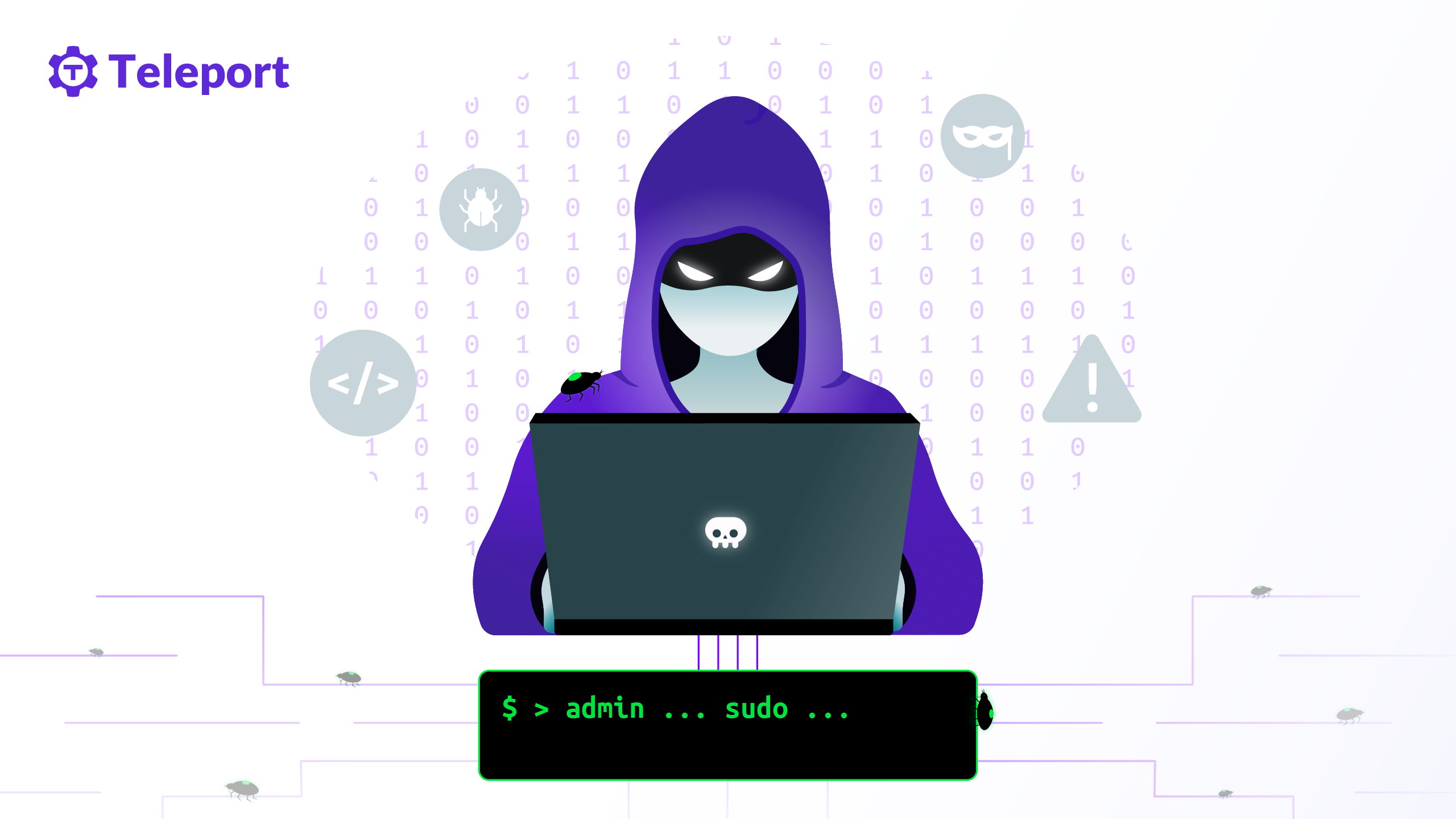Teleport Blog - How to Stop Container Escape and Prevent Privilege Escalation - Mar 18, 2022
How to Stop Container Escape and Prevent Privilege Escalation

Container escape is a security risk in which malicious players can leverage a containerized application’s vulnerabilities to breach its isolation boundary, gaining access to the host system’s resources.
Once an attacker accesses the host system, they can escalate their privilege to access other containers running in the machine or run harmful code on the host. Depending on how vulnerable the host is, the actor could also access other hosts in the network.
Needless to say, container escape and privilege escalation attacks can be devastating — costing you sensitive information from files or databases or leading to entire applications going down. For example, in 2020 two vulnerabilities were discovered in Azure Functions that allowed attackers to escape the Docker container, escalate privileges, and execute code to overwrite packages.
As a security-aware administrator or developer, you need to know how to prevent such attacks. This article will demonstrate how container escape works and how to mitigate this risk.
How do container escapes happen?
Attackers logged into a container can exploit different vulnerabilities:
- Leveraging any software running with privileged mode to run malicious commands on the host
- Building and running a container with bind parameters to mount the host’s filesystems and deploy payloads to them
- Exploiting vulnerabilities like kernel bugs, poor configuration, or weak access controls for privilege escalation
- Escalating privilege on the host to access other containers
What happens when a container is escaped?
After escaping the container, an attacker will attempt to escalate their privilege. Privilege escalation means the attacker logs into the host system using an account with elevated access privileges. With this, the attacker gains control of the whole system.
With privilege escalation, attackers can cause mayhem. They can stop and destroy all containers running on the host, start their own containers using malicious code, access databases or files in the machine or network, mount volumes, remove or corrupt critical configuration files, run crypto mining, or worst of all, connect to a C2 server to await further instructions.
The ImageMagick example
ImageMagick is a platform to edit, compose, and convert digital images. It consists of multiple command line tools and programming language binaries commonly used in applications for image processing, such as changing the format, resizing, and other transformations.
Unfortunately, ImageMagick involves several weaknesses, including the infamous ImageTragick vulnerability that can cause command injections or remote code execution. The vulnerabilities can also lead to file deletion or moving and server-side request forgery (SSRF).
Say you’re developing an image processing application using ImageMagick code. But ImageMagick’s code may have vulnerabilities within itself that are exploitable. How do you prevent that?
Instead of running it on a host (physical or virtual) by itself, you can run ImageMagick as a containerized application. By default, a container runtime creates an isolation layer between a host and the application container and between containers running on the same host. Containers reduce an application’s surface area, protecting the host by blocking access to it.
You have other options as well:
- Containerize only stable versions of ImageMagick.
- Enable least required permissions for your code that calls ImageMagick libraries.
- Run ImageMagick binaries with minimal permissions and minimal network access.
- Run separate, stripped-down versions of ImageMagick libraries in separate containers for different image processing tasks.
- Run vulnerability scanners and automatically apply security patches on both the container runtime and ImageMagick.
Without such basic but necessary steps, you risk any vulnerabilities being exposed and exploited — even within a containerized setup.
How to prevent container escape and privilege escalation
But are these measures enough to prevent container escape and privilege escalation? Not always.
New vulnerabilities are regularly discovered in container runtimes like Docker or orchestration platforms like Kubernetes. You can patch them, but the threat landscape is always evolving.
The key to ensuring security is to implement multiple layers of defense mechanisms between the container and an attacker. Here are some ways you can do so:
Use a robust authentication system
An authentication mechanism can largely prevent attackers from accessing your containers and escalating privileges. Such mechanisms may include risk-based authentication RBA, context-based access controls, multi-factor authentication, role-based access control (RBAC), or privileged access management (PAM).
Enabling Zero Trust security and the principle of least privilege for the containerized application also reduces risk.
Implement a strong network policy
A solid network security policy permits only specific traffic types or sources to a given network, host or application. This can be applied at the container level, so only specific ports are exposed from the container. Strict network policies can also isolate host clusters to their subnets, enabling network or host-based intrusion prevention systems and alerting.
Don’t run containers as root
While container runtimes may need root access to run, containers don’t; however, in many cases, developers run it as root because it’s easier. Root users can access, read and write any file in the host’s file system, and running containerized applications as the root user allows container escape.
To address this issue, you can set up a policy to restrict developers or administrators from running containers as root. For example, you can specify a non-root user when creating container images, enabling the minimal system access required to execute tasks. You can also utilize user namespace when running processes in a privileged container.
Also, creating a user with a known GID and UID in a Dockerfile and running your processes with that user can help secure your container during runtime.
Adopt safe image practices
Use security best practices when creating container images.
When a container builds, it layers different changes on top of the base image. Often, the base image is sourced from a public image repository. Instead of depending on public repos, use private registries where base images are already downloaded and pre-scanned for vulnerabilities. You can also use Kubernetes security scanners to check for vulnerabilities in your existing container images.
Automate the image build process and incorporate vulnerability scanning. Once a new image version is built, all containers running old versions should be gradually migrated to the latest one.
Furthermore, you can use docker scan to detect vulnerabilities in Docker local images. It will help you deeply analyze an image’s security
posture and take immediate actions as needed. You can trigger the scan from the command line to see the vulnerabilities detected. Fixing
these issues will allow secure container deployments.
Patch and upgrade containers
When a vulnerability scanner finds an issue with a running container, it may not always be possible to stop it immediately and start with an updated image. This is where immediate patching and upgrading can help thwart any possible attack.
Monitor the runtime environment
Some vulnerabilities always remain hidden and can lead to security risks; therefore, it’s essential to proactively monitor the application in the runtime environment for anomalies. This involves analyzing runtime logs, user activities, network traffic, file access patterns, and other data. There are both open source and commercial monitoring solutions like Nagios, Splunk, OSSEC, or Snort that can automate application monitoring.
Team effort
Lastly, implementing an effective defense requires a team effort. Having skilled and responsible professionals in your team can help you maintain security for your containers and the clusters that run them.
Using serverless functions as alternative
In today’s cloud-native world, most organizations have either migrated some or all of their workloads to the cloud or are considering doing so. Public cloud providers now offer features that can run what’s known as serverless functions.
Serverless functions are small code snippets that run in the cloud providers’ managed environments. Behind the scenes, the cloud provider ensures the compute runtime is always available for running the user’s code. Once the code finishes, the runtime is destroyed. Every time the code runs, a new compute environment is assigned to it. The only drawback is that, due to the ephemeral nature of the underlying compute environment, the user’s code cannot persist data in the compute environment—although it can do so in other mediums like the cloud provider’s object storage. AWS offers this feature via AWS Lambda, GCP via Cloud Functions, and Azure via Azure Functions.
Depending on the use case, this can be a good replacement for running your own containers — either in dedicated hosts or in managed environments — which eliminates the risk of container escape and privilege escalation. An application based on serverless functions can be hewn together with API Gateway to delegate certain features to different serverless functions, and the Gateway can route client requests to the appropriate functions.
Using the ImageMagick example, a graphics application might perform manipulations on user-uploaded images using separate serverless functions. Each function could call the relevant ImageMagick library necessary for its task, and the serverless code could load the ImageMagick libraries as part of its initialization. Once the code finishes running, the runtime containing the ImageMagick library would also be removed.
Teleport cybersecurity blog posts and tech news
Every other week we'll send a newsletter with the latest cybersecurity news and Teleport updates.
Conclusion
Container escape and the ensuing privilege escalation are severe security risks. Attackers can leverage vulnerabilities in your containerized applications to reach the host and take control of it — accessing sensitive data or causing service disruption. Still, there are steps you can take to minimize or eliminate this risk so that you keep your applications safe.
Additional Reading: How to SSH into Docker Container
Tags
Teleport Newsletter
Stay up-to-date with the newest Teleport releases by subscribing to our monthly updates.

Subscribe to our newsletter

